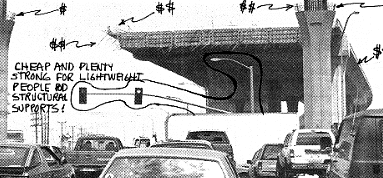How can SkyTran per-mile costs be so low?
Because of the minuscule vehicle weight, an elevated guideway can be built with minimum materials for less than $1 million per mile and still exceed all static, dynamic and seismic structural criteria. This is much less than the cost of any paved road, rail transit or monorail system simply because the structure is highly specialized to carry 600 pound People Pod vehicles and does not have to safely support the 80,000 pound trucks that share the roads with all automobiles. The light weight per foot of the track design also allows the use of a semi-automated track forming manufacturing robot (much simpler than the Robosaurus machine) that enables a two shift crew to deploy one mile of two way track per day. This can be compared with proposed monorail trains (weighing 100,000 pounds) which require guideways costing well over $40 million per mile and many years to build.
Preliminary concept for a TRACK FORMING ROBOT
We have done a lot of analysis that we don't want to bore you with here, however, want to put the next table in to give you a rationale for the claimed $1 million per mile figure.
SkyTran per mile Track Costs
| Item | Requirements |
Cost per Unit |
Number Needed |
Total Installed Cost |
| Support Poles | Tapered steel tubular support structure and footings located every 30 feet. |
$2,900 installed |
176 |
$510,400 |
| Monorail Track | One mile of straight lanes, with separate parallel 1,000 foot long deceleration/acceleration lanes, plus parking lanes for extra vehicles, and all exit lanes and merging lanes. |
$127,000 |
2 |
$254,000 |
| Stations | Ticketing, controls, etc. - allocated per mile (it's a bus stop, not a $2 million building!) |
$20,000 installed |
1 |
$20,000 |
| Systems | Control, electrical power, safety and communication per mile. |
$100,000 installed |
1 |
$100,000 |
| Labor | Extra labor for running and maintaining automated track roll forming machines allocated per mile. |
$25,000 |
1 |
25,000 |
| Miscellaneous | Right of ways, overhead, other per mile. |
$5,000 |
1 |
$5,000 |
| TOTAL | Total for entire system per mile |
$914,400 |
For any of the above to be believable one needs to just consider the zillion pounds of materials and labor that go into regular roads and overpasses (capable of supporting 80,000 pound trucks safely for decades). The following picture should help put that in perspective. Compare the simple light pole structures we use to support the SkyTran tracks with all that rebar and concrete! Also keep in mind that the little light poles support two tracks that can move more commuting people per hour then that concrete nightmare! (SkyTran is for Commuters only - you still need the road system to move all heavy commercial goods and to enable small trucks carrying tools get from job to job.)
The same tapered steel light poles are utilized by windmill manufacturers because of their low cost and high bending strength capacity. When you produce a lot of identical products, costs can come way down - if you set up your factory with good technology.
Concrete and Rebar compared to structurally efficient tapered steel tubes!

